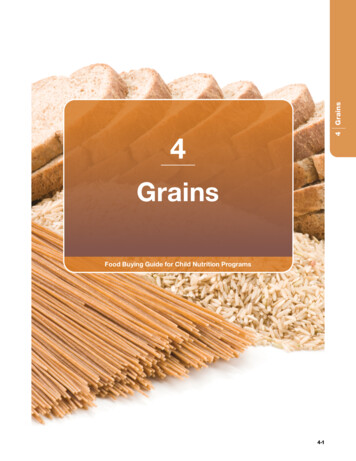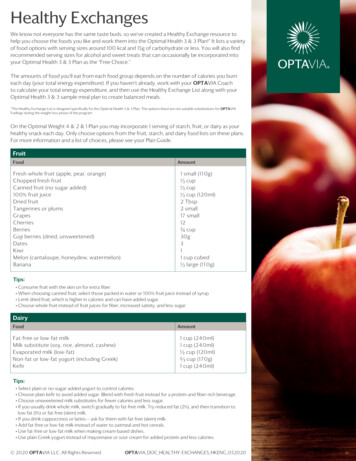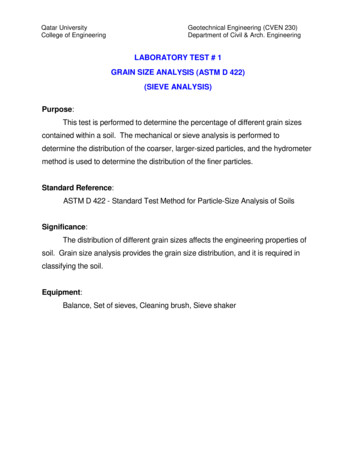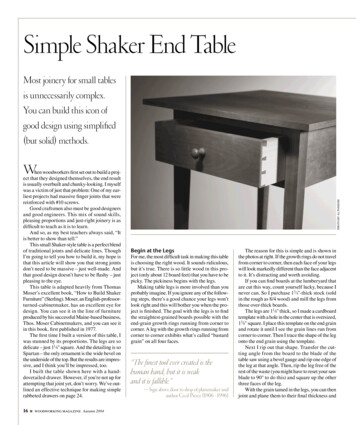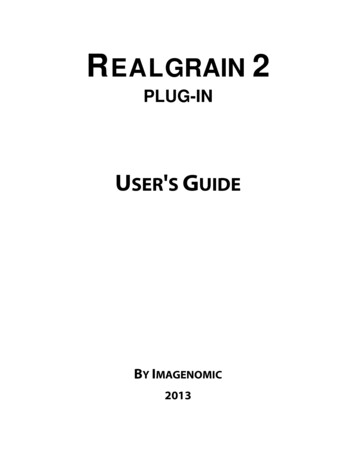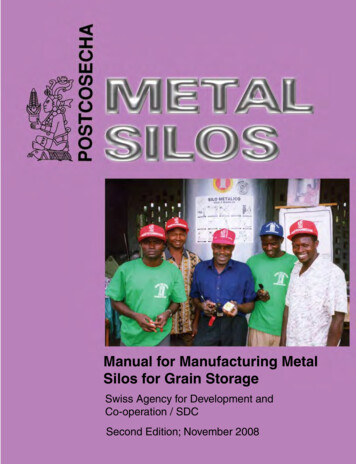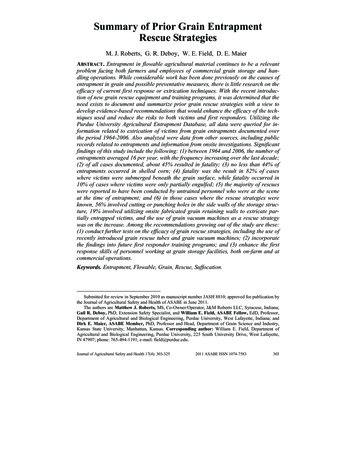
Transcription
Summary of Prior Grain EntrapmentRescue StrategiesM. J. Roberts, G. R. Deboy, W. E. Field, D. E. Maier*ABSTRACT. Entrapment in flowable agricultural material continues to be a relevantproblem facing both farmers and employees of commercial grain storage and handling operations. While considerable work has been done previously on the causes ofentrapment in grain and possible preventative measures, there is little research on theefficacy of current first response or extrication techniques. With the recent introduction of new grain rescue equipment and training programs, it was determined that theneed exists to document and summarize prior grain rescue strategies with a view todevelop evidence-based recommendations that would enhance the efficacy of the techniques used and reduce the risks to both victims and first responders. Utilizing thePurdue University Agricultural Entrapment Database, all data were queried for information related to extrication of victims from grain entrapments documented overthe period 1964-2006. Also analyzed were data from other sources, including publicrecords related to entrapments and information from onsite investigations. Significantfindings of this study include the following: (1) between 1964 and 2006, the number ofentrapments averaged 16 per year, with the frequency increasing over the last decade;(2) of all cases documented, about 45% resulted in fatality; (3) no less than 44% ofentrapments occurred in shelled corn; (4) fatality was the result in 82% of caseswhere victims were submerged beneath the grain surface, while fatality occurred in10% of cases where victims were only partially engulfed; (5) the majority of rescueswere reported to have been conducted by untrained personnel who were at the sceneat the time of entrapment; and (6) in those cases where the rescue strategies wereknown, 56% involved cutting or punching holes in the side walls of the storage structure, 19% involved utilizing onsite fabricated grain retaining walls to extricate partially entrapped victims, and the use of grain vacuum machines as a rescue strategywas on the increase. Among the recommendations growing out of the study are these:(1) conduct further tests on the efficacy of grain rescue strategies, including the use ofrecently introduced grain rescue tubes and grain vacuum machines; (2) incorporatethe findings into future first responder training programs; and (3) enhance the firstresponse skills of personnel working at grain storage facilities, both on-farm and atcommercial operations.Keywords. Entrapment, Flowable, Grain, Rescue, Suffocation.Submitted for review in September 2010 as manuscript number JASH 8810; approved for publication bythe Journal of Agricultural Safety and Health of ASABE in June 2011.The authors are Matthew J. Roberts, MS, Co-Owner/Operator, J&M Roberts LLC, Syracuse, Indiana;Gail R. Deboy, PhD, Extension Safety Specialist, and William E. Field, ASABE Fellow, EdD, Professor,Department of Agricultural and Biological Engineering, Purdue University, West Lafayette, Indiana; andDirk E. Maier, ASABE Member, PhD, Professor and Head, Department of Grain Science and Industry,Kansas State University, Manhattan, Kansas. Corresponding author: William E. Field, Department ofAgricultural and Biological Engineering, Purdue University, 225 South University Drive, West Lafayette,IN 47907; phone: 765-494-1191; e-mail: field@purdue.edu.Journal of Agricultural Safety and Health 17(4): 303-3252011 ASABE ISSN 1074-7583303
Entrapment in flowable agricultural material continues to be a relevant problemfacing both farmers and employees of commercial grain storage and handlingoperations. While considerable work has been done previously on the causes ofentrapment in grain and possible preventative measures, there is little research on theefficacy of current first response or extrication techniques. With the recent introduction of new grain rescue strategies, equipment, and training programs, it was determined that the need exists to develop evidence-based recommendations that wouldenhance the efficacy of the techniques used and reduce the risks to both victims andfirst responders. Therefore, the specific objectives of this study were: (1) review priorpublished grain rescue strategies and their efficacy and summarize for incorporationinto current training programs; (2) document and summarize from the Purdue University Agricultural Entrapment Database previously used rescue strategies employedduring actual entrapments; and (3) develop evidenced-based recommendations forfuture first responder training.Utilizing the Purdue University Agricultural Entrapment Database developed byFreeman et al. (1998) and Kingman et al. (2003), all data were queried for informationrelated to extrication of victims from grain entrapments documented over the period1964-2006. Also analyzed were data from other sources, including public records related to entrapments and information from onsite investigations.Significant findings of this study include the following: (1) between 1964 and2006, the number of entrapments averaged 16 per year, with the frequency increasingover the last decade; (2) of all cases documented, about 45% resulted in fatality; (3) noless than 44% of entrapments occurred in shelled corn; (4) fatality was the result in82% of cases where victims were submerged beneath the grain surface, while fatalityoccurred in 10% of cases where victims were only partially engulfed; (5) in thosecases where the rescue strategies were known, 56% involved cutting or punching holesin the side walls of the storage structure (this strategy was used for both partially entrapped and fully engulfed victims), 19% involved utilizing onsite fabricated grainretaining walls to extricate partially entrapped victims, and the use of grain vacuummachines as a rescue strategy was on the increase; and (6) injuries and secondary entrapments were documented occurring to 14 emergency first responders at the scene ofgrain entrapments, including six who died as the result of being involved in the rescueattempt. None of the six were members of professional or volunteer emergency response teams.Statement of the ProblemIn this article, the term “entrapment” is used in a broader sense to describe events inwhich an individual is trapped, possibly due to engulfment in flowable agriculturalmaterial, such as corn, small grains, and feed, inside a structure considered a confinedspace (e.g., silo, bin, grain transport vehicle, outdoor pile, or bunker silo) where selfextrication is not possible. The term “engulfment” is used to describe events in whichan individual is submerged (i.e., fully buried) in flowable agricultural material, such ascorn, small grains, and feed.From the time Purdue University began documenting cases of flowable agriculturalmaterial (FAM) entrapment and engulfment in the mid-1960s, efforts have been madeto better understand the contributing causes of these incidents in order to improve thedesign of grain storage and handling facilities, encourage compliance with safe work304Journal of Agricultural Safety and Health
practices, and increase the relevance of preventative educational material. Due to thegrowing frequency of such incidents during the 1960s and 1970s, the U.S. Occupational Safety and Health Administration, Cooperative Extension personnel, grain binmanufacturers, the media, and the grain industry began to educate farmers and commercial elevator operators about the dangers associated with FAM entrapments andengulfments and to explore possible intervention strategies. Even with those efforts,the current national average is no fewer than 23 documented entrapments annually,and that frequency appears to be increasing, with 33, 38, 42, and 51 cases documentedin 2007, 2008, 2009, and 2010, respectively (Riedel and Field, 2011). Approximatelyhalf of these more recent entrapments resulted in fatality.Because entrapment continues to be a relevant problem and has a high probabilityof fatality, there has been growing interest in both developing more effective preventative strategies and first response or extrication techniques. Historically, the primaryfirst response approach was body recovery, due to the high frequency of death (Bakeret al., 1986). In some cases, rescue procedures actually contributed to the death of victims and/or caused secondary entrapment of rescuers. The extrication method mostwidely used was cutting holes in the wall of the bin to release the grain from aroundthe victim (Field et al., 1999). In the 1990s, researchers and emergency response professionals began developing and testing FAM rescue procedures based on confinedspace rescue techniques similar to those used in non-agricultural settings (Maier et al.,1999). Such techniques typically employed high-angle/rope rescue systems and specialized equipment, such as temporary grain retaining walls (GRWs) that were fabricated onsite.While much was known about general industry confined-space and high-angle/roperescue practices, a review of the literature revealed only scant information about theapplication of these approaches to FAM entrapments and engulfments. Even though anumber of professionals and organizations were conducting FAM rescue training foremergency first responders, there was a lack of sound research upon which to designthe training curriculum contents. In some cases, the information being disseminatedwas not well understood or eventually proven to be incorrect.It was thus concluded that a need existed to develop evidence-based rescue strategies, especially with respect to the use of GRWs, including the grain entrapment rescue tube (GERT), which was introduced as a form of grain retaining system to protectthe partially entrapped victim from further entrapment from in-flowing grain and toaid in extrication. There was also need to summarize prior rescue techniques anddocument the current strategies being used in real-world situations in order to developrecommendations for rescue protocols and preventative strategies that would reducethe likelihood of FAM-related incidents being fatal.Literature Review and Prior ResearchGrain Entrapment ResearchSince the late 1960s, Purdue University has been gathering data on incidents involving flowable agricultural material (FAM) entrapments in agricultural confinedspaces (Kingman et al., 2001). Previously documented incidents have been coded andcatalogued in the Purdue University Agricultural Entrapment Database (PUAED). Theoverwhelming majority of cases in the database involve entrapment and engulfment in17(4): 303-325305
stored grain. Analysis of the data has resulted in several publications related to grainentrapment, including Kelley and Field (1995), Freeman et al. (1998), Kingman et al.(2001), Kingman et al. (2003), and Kingman et al. (2004). Although prior work hasprovided valuable analysis of causal factors associated with entrapment situations,these earlier studies did not fully explore the rescue dimension involved with previousFAM entrapment incidents.The only identified prior research that related directly to grain entrapment rescuewere those conducted by Schwab (1982) at the University of Kentucky and bySchmechta and Matz (1971) in Germany. Schwab analyzed the speed at which a person can become entrapped in grain and the amount of vertical pull needed to extricatea person so entrapped. Schmechta and Matz evaluated the speed at which a personsank into a column of grain being unloaded from the bottom; they also studied theability of entrapped persons to free themselves when buried to various depths. Thefindings of both Schwab (1982) and Schmechta and Matz (1971) indicated that:(1) self-extrication was possible when an individual was entrapped to the knees,(2) self-extrication was possible but with considerable difficulty when entrapped to thewaist in non-flowing grain, and (3) self extrication was not possible when entrapped tothe chest. Schmechta and Matz also found that, when entrapped to the chest, breathingwas made more difficult due to the added pressure of the grain.Grain Entrapment RescueInitial anecdotal findings concerning possible grain entrapment rescue strategiesbased upon Purdue’s early investigations of FAM incidents were first outlined in anaudiovisual presentation by McKenzie (1971) used for extension education programs.He reported that most FAM entrapments were fatal and that onsite fabricated grainretaining walls (GRWs), including barrels with both ends cut out, had been used toassist in victim extrication.FAM rescue strategies based on the Purdue investigations were published in the1980 edition of “Farm Rescue” (Baker et al., 1980), with additional findings incorporated in the 1986 and 1999 editions (Baker et al., 1986; Field et al., 1999). In the 1999edition, with over 135,000 copies distributed nationwide (primarily to emergency response personnel), specific rescue strategies were recommended for extrication ofvictims from small (i.e., 20,000 bushels) on-farm grain storage structures. One suchstrategy involved rapidly removing the grain from around the entrapped victim bycutting V-shaped holes, spaced equal distance apart, around the perimeter of the bin.(However, rescuers were cautioned that too many openings and/or openings that weretoo large might jeopardize the structural integrity of the bin.) Another strategy described was an onsite fabricated GRW constructed around a partially entrapped victimto protect him from additional in-flow while the surrounding grain was being removed. These recommendations had application to both smaller commercial and onfarm structures; however, no information was provided regarding the problems associated with emergency evacuation of grain from larger commercial storage units, including concrete silos and steel tanks.In 1987, Iowa State University published a series of pamphlets on grain elevatorsafety for distribution to commercial grain storage and handling operations (ISU,1987). Funded by the USDA, the series covered 14 topics, one of which was “Suffocation Hazards Associated with Stored Grain.” This pamphlet discussed ways in whichindividuals become entrapped, cautioned about toxic atmospheres, provided guidelines306Journal of Agricultural Safety and Health
for bin and tank entry, and addressed emergency procedures following entrapment.Rescue situations involving completely engulfed and partially entrapped victims wereconsidered. In both instances, the authors suggested cutting evenly spaced holesaround the base of the bin; however, again, no information was provided regarding theuse of GRW devices, limitations on the size of structure that could be breached, or thepotential of structural failure.In 1993, the American Academy of Orthopedic Surgeons published “Rural Rescueand Emergency Care,” which provided a rather detailed account of grain facility rescue techniques (Worsing et al., 1993). Topics that needed to be addressed for safe confined-space rescue were identified, including pre-incident planning, hazardous atmospheres, physical hazards, psychological hazards, and rescue techniques associated withgrain entrapment. Special consideration was given to the use of GRWs and to cuttingopenings in the side of grain storage structures. In the section about onsite implementation and use of fabricated GRWs, the authors recommended that “the shield (GRW)should be made of plywood forced vertically into the grain. Three sheets may be usedto form an overlapping triangle, or four sheets in a square or rectangle with overlapping edges. A section of snow fence covered with canvas also makes a lightweight,portable shield.” No mention was made as to the source(s) of that information orwhether the shield designs had been tested.Several newsletters, general extension publications, and books also raised concernsabout FAM entrapment and extrication (Field, 1980; Aherin and Schultz, 1981;Aherin, 1987; Allen and Noyes, 1994; Mulhern, 1997). There has also been extensivecoverage of the hazards related to FAM in the general farm printed media.In 1999, preliminary findings from Purdue University’s collection of entrapmentcase studies were incorporated into a National Feed and Grain Association sponsoredtraining program titled, “Don’t Go with the Flow” (Maier et al., 1999), which wasdesigned for commercial grain industry personnel involved with day-to-day grain handling operations. The material described rescue strategies based on confined spacerescue techniques in general use at the time and identified by a formal process using apanel of experts. The following seven steps were recommended to be taken in event ofa grain entrapment:1. Stop! Never rush into an entrapment situation in an attempt to rescue the victim.2. Shut down and lock out all unloading equipment.3. Activate local emergency fire rescue services and plant first response personnel.4. Turn on aeration and roof exhaust fans.5. Assemble employees at a predetermined location.6. Assess situation and resources, including: stability of grain mass, condition ofvictim, air quality inside structure, availability of necessary rescue equipment,and personnel best suited to carry out the rescue.7. Implement a situation-specific action plan.Efforts to develop portable grain rescue tubes were first reported by Carpenter andBean (1992), who reported on a tube designed and built by the Andersons Grain Company and later used in an actual rescue. A patent search identified one grain rescuetube design (U.S. Patent No. 6,062,342) submitted by Dale Dobson (Dobson, 2000).Kingman et al. (2001, 2003, 2004) reported on efforts to develop prototype grain rescue tubes using a variety of materials. In 2006, two tube designs were introduced atthe Grain Elevator and Processing Society Exchange in Nashville, Tennessee. One17(4): 303-325307
was manufactured by Regulatory Consultants, Inc., and the other by Liberty RescueSystems based upon the Kingman design.No research was identified that actually assessed the efficacy of any specific grainentrapment response strategy or the equipment used, such as cutting open the structureor using GRWs or rescue tubes. This lack of research-based information has contributed to the uncertainty regarding the most appropriate first response measures, andthus places first responders at risk of injury or death, which was documented in thisstudy.Research MethodologyThe Purdue University Agricultural Entrapment Database (PUAED) was established as a means of consistently coding and storing data on both fatal and non-fatalincidents involving flowable agricultural material (FAM) and agricultural confinedspaces. The database contained data on 686 FAM-related cases documented from1964 through 2006, which were analyzed for this study. Case reports were derivedfrom newspaper clippings, case studies submitted by agricultural safety professionals,state and federal reports, internet searches, death certificates, onsite investigations, andproceedings from civil litigation. The clippings of incidents reported in the press weregathered through a long-term subscription service that yielded over 12,000 reports offarm-related incidents from throughout the U.S. These were screened for cases involving confined spaces in agriculture. In addition, media reports were received from avariety of sources, including voluntary reporting.Being comprised of information from many sources, the database does not consistently nor comprehensively cover all details related to every FAM entrapment case,nor does Purdue imply such, since many incidents go unreported for a variety of reasons explained in other articles (see Kingman et al., 2004).A search of the PUAED uncovered 323 cases (47%) that contained sufficient information for use in this study dealing with rescue strategies. Only limited follow-upinvestigations were conducted to gain further information on cases that had been entered into the database. However, significant effort was made to gather more completeinformation on additional cases that were documented during the course of the study,including conducting onsite investigations. It is important to note that, of the casescontained in the database, 52% provided no information regarding the rescue attemptsor strategies used. In fact, in 74% of the cases, the rescue was reported simply as“body recovery,” which reflects the high fatality rate associated with these incidents(Kingman et al., 2004). The cases identified and summarized provide the best understanding of the rescue strategies currently being utilized.Although most of the cases contained in the PUAED involved grains and oilseeds,some had been documented that involved other agricultural materials, such as silage,hay, and fertilizer in confined spaces like silos and storage bins. These cases were notincluded in this study; but it should be noted that successful rescues from these othermaterials were rare and often presented a set of complex issues to first responders,such as removal of massive amounts of bulk material.The PUAED also contained reports of incidents that occurred in grain transport vehicles (GTVs). Again, such cases were not included in this study. However, entrapments in or rescues from GTVs, with respect to causative factors, have been analyzed308Journal of Agricultural Safety and Health
elsewhere (see Freeman et al., 1998; Kelly and Field, 1995; Kingman et al., 2001;Kingman et al., 2003; and Kingman et al., 2004).This present study was undertaken to analyze documented FAM cases in thePUAED and to summarize the data concerning rescue situations, rescuer characteristics, types of rescue equipment used, techniques attempted, and rescue success rates.The information presented is a summary of the findings and includes data from bothfatal and non-fatal incidents involving FAM in both commercial and on-farm structures. It is felt that analysis of the PUAED rescue information, along with supplemental documentation gathered through follow-up investigations, yielded findings thatshould enhance the reliability of future recommended rescue practices, including whathas been attempted, what works, what does not work, what equipment has provenmost useful, and what precautions are needed to prevent secondary victims.The importance of this research was confirmed during two FAM incidents that occurred near completion of this study. In both cases, a serious conflict took place at thescene among the different first responder groups present as to the most appropriatestrategy to follow to extricate the entrapped victims. In one case, the efforts were successful despite the conflict; in the other case (discussed later), they were not.Identifying the CasesThis research was conducted using the currently available data in the PUAED plussupplemental case study information. A description of how these data were originallygathered, stored, and queried has been presented elsewhere (see Kingman et al., 2001).Since its development, the PUAED has been continually updated with new casesand information from cases identified during earlier periods. Approximately 30 to50 new cases are added annually. The more recent cases have been discovered throughinternet searches of articles related to this topic, grain industry email alerts (e.g., GrainElevator and Processing Society [GEAPS] industry alerts) and in-depth findings collected from civil litigations and onsite investigations. In the internet searches for FAMentrapment cases, Google alerts and Newslibrary.com search engines were used.Keywords for those searches included: “farm accident,” “farm injury,” “grain bin,”and “silo.”It has been determined that not all incidents are reported in the public media, especially those not resulting in a fatality or those in which the victim was able to selfextricate and was unwilling to report the incident. This conclusion is based on anecdotal observations involving discussions with first responders, farmers, and commercialelevator personnel at various fire/rescue training events, agricultural trade shows, andgrain industry expositions where the Purdue Agricultural Safety and Health Programstaff was distributing grain entrapment and general farm safety information. At theseevents, the staff spoke to individuals who had been entrapped in grain storage structures and were either rescued by co-workers or had extricated themselves. Whenevermentioned, these accounts were noted by Purdue staff and later checked against thedatabase. Usually such cases, especially non-fatal cases, had not been previously recorded. Typical reasons for past victims’ reluctance to report their experiences included embarrassment, fear of punishment by supervisors, and fear of external regulatory involvement. No good estimate exists as to the frequency of or contributing factors associated with these undocumented cases. In addition, it was found that summaries of farm-related fatalities and injuries from state and U.S. Department of Laborsources (e.g., NIOSH) did not comprehensively document FAM incidents.17(4): 303-325309
Type ofstructure# of emergencyrescuersDescription ofmistakes madeMonthSexFarm type 1WorkingLast nameNewspaperclippingNoneTable 1. Criteria fields for data entry into the PUAED.# of workersRescuerSize of# of all agenciesnearbyeffectsstructureinvolved# of all# of emergencyEquipmentRescuerescuersagenciesused in rescuetechniquesusedTotal timeTotal timeVictim effectsDepth ofof entrapmentfor ionshipWork statusFarm type 2Accident type Agent of injuryLocationUsed safetyFatalityNarrativeMediumequipmentFirst nameContact nameContact titlePhone numberDeathState extension Accident reportOthercertificatereport(non-state)Source notesNon-farmAgentRescue info.casecategoryentered# of directobserversAre rescuers trainedin grain entrapmentrescue?Was a grainretaining wall used?AgeResidence farmClassificationGrain movementCase info. notesUnknownEntering the DataAll documented cases were coded using a standardized coding form and then entered into the PUAED, which utilizes Microsoft Access database software. Columnheadings for the 59 previously established criteria fields (Kingman, 2002) are listed intable 1. As already noted, not all cases entered into the PUAED have enough information available for data entry into each of the criteria fields. If information was notavailable for a particular field, then no entry was made in that field.Running the QueriesQueries can be quickly and easily performed with the PUAED, allowing data to besorted and analyzed and comparisons made. The ability to mine the information in thedatabase permits users to find and analyze what had been documented concerning pastFAM rescue attempts.The general information fields that were queried for inclusion in this research studywere: Type of structure, Size of structure, Total time of entrapment, Victim effects,Depth of entrapment, Year, State, Farm type 1 (primary farm business, i.e., grain,beef, dairy, poultry), Fatality, and Medium. This information was queried in order toget a better overall picture of grain entrapment incidents, allowing for evaluation offrequency, locations, and types of entrapments.Within the PUAED, there were 373 cases that included some information on entrapment rescue attempts. That information was queried from the following criteriafields: Rescuer effects, # of emergency rescuers, Equipment used in rescue, Rescuetechniques used, Were rescuers trained in grain entrapment rescue?, Description ofmistakes made, Total time for rescue, Was a grain retaining wall used?, and Rescueinformation entered.The majority of queries were single-criterion queries. The fields were examined individually and tallied. In some cases, queries prompted investigation into other criteriafields when the generated data needed additional explanation. Deciding which fields toquery was determined by evaluating those fields that included the most informationthought to be useful from a grain entrapment rescue standpoint. An example of someof the criteria fields that were not explored included: Name of the entrapped person,310Journal of Agricultural Safety and Health
County in which the entrapment took place, and the Time of day the entrapment occurred.Also available for review and analysis were hard copies of the reports of grain entrapments, including printed and online news articles, video clips, and documents generated from prior litigation, such as police reports.Findings of the StudyGeneral Observations Concerning Grain EntrapmentsBeginning in the late 1950s, grain harvesting and handling technology changedsubstantially, with a rapid increase in on-farm storage as well as the construction oflarger commercial and on-farm storage structures. In the Midwest, much of thischange was driven by the switch from harvesting ear corn to harvesting shelled corn.The growth of on-farm storage and the conversion to shelled corn have been the primary factors leading to an increase in flowable agricultural material (FAM) entrapments. Of the 686 cases documented in the Purdue University Agricultural EntrapmentDatabase (PUAED), 67% occurred on farms, with the remainder primarily at commercial sites. A review of the more recent cases, however, shows a growing number ofincidents now happening at commercial grain storage sites (Roberts and Field, 2010).In entrapment cases where the grain type was known, 49% occurred in shelled corn. Inall known cases, the number one identifiable factor that led to victims entering grainstorage spaces was spoiled or out-of-condition grain.Entrapments have been documented in the PUAED in all but nine states: Louisiana,Maine, Nevada, New Hampshire, New Mexico, Rhode Island, Vermont, Washington,and Wyoming. The bulk of incidents (over 55%) have occurred in the Midwest CornBelt states of Iowa, Illinois, Indiana, Minnesota, Ohio, and Nebraska. This list closelyparallels states with the greatest s
ture, 19% involved utilizing onsite fabricated grain retaining walls to extricate par-tially entrapped victims, and the use of grain vacuum machines as a rescue strategy was on the increase. Among the recommendations growing out of the study are these: (1) conduct further tests on the efficacy of
